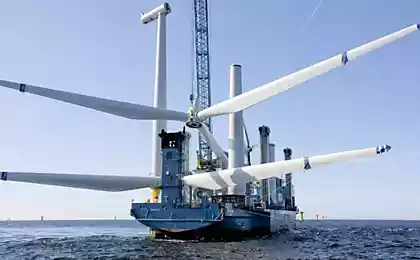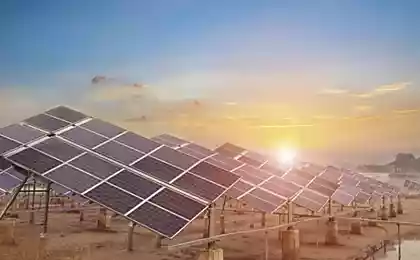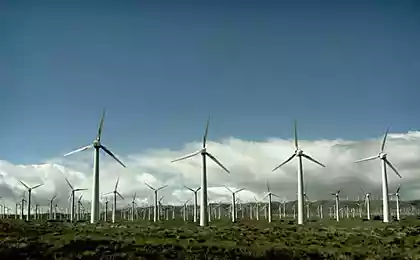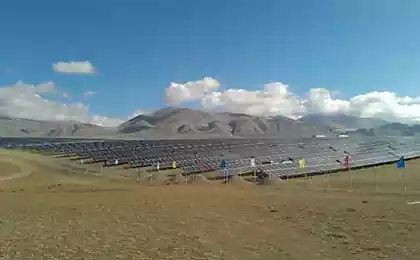640
New developments in the field of solar energy
Developed high-performance microscopic solar panels, a Team of scientists of the University of Wisconsin-Madison have developed a high-performance, microscopic solar cells. The miniature solar panel is able to make a breakthrough in the technology of personal devices, wearable medical sensors, smartwatches and self-guided contact lenses.
One of the authors of the development Hongrui Jiang explains that large photovoltaic arrays generating electricity from the charges moving vertically. New, little cells capture the current from the charges moving from side to side or laterally. Because of this, they generate significantly more energy than other solar system. A new generation side of solar cells can revolutionize the compact wearable device as the electrodes horizontally allows technologists to circumvent the traditional process of manufacturing a solar cell, when it is difficult to combine several layers of material one above the other.
Jiang says, "From the point of view of workmanship, will always be easier to make a lateral structure. Laying the vertical structure in several stages, is very challenging in small scale." The new solar cells reach an efficiency of 5.2 percent. "In other structures, a lot of volume is wasted. The technology that we have developed, allows a very compact side structures that take advantage of the full amount," say the creators.
Now, inventors are trying to make their solar panels are smaller and more efficient, by examining the materials, to further optimize the transparency and conductivity. Eventually, engineers plan to develop a flexible solar battery that can provide power to a tunable contact lenses.
Selenium can improve the effectiveness of tellurium-cadmium solar batteriesand much more effective than classic silicon as absorbing the same amount of solar energy use 98% less semiconductor material, but their efficiency can be improved.
Scientists have studied 4 solar panels with different levels of selenium and found that there is an optimal concentration of the alloy containing 50% cadmium, 25% of tellurium and 25% selenium. This alloy can improve the current efficiency of a tellurium-cadmium panels with 22.1% to 33% — a record high. If you exceed the percentage of selenium in the alloy, the result will give the opposite result with a decrease in the effectiveness of the panels.
"We have shown that the amount of selenium in the alloy of tellurium with cadmium depends on whether the form of small crystals in a solar cell crystal structure A or B — said Poplawski. — This information can be used as a guide for manufacturers to improve the tellurium-cadmium solar batteries supplements of selenium with a view to increasing their overall efficiency," — said the head of the team of the center for nanophase materials Jonathan Poplawski.
India appears rickshaws with electric motorsIn the state of Kerala in southwest India will soon appear rickshaws with electric motors, powered by solar energy. It is reported by Indian newspaper the Hindu. It is planned that they will replace so popular in the country tricycle motorickshaws.
Local entrepreneur hopes to launch the project on August 15 this year. These rickshaws are driven by an electric motor which will be powered by a battery, podzaryadit from solar panels installed on the roof. The batteries also can be recharged from a regular power outlet. Electronica has five seats and can travel on a single charge distance up to 80 kilometers. To collect it will be the company Lifeway Solar Private Limited in Kochi Kerala.
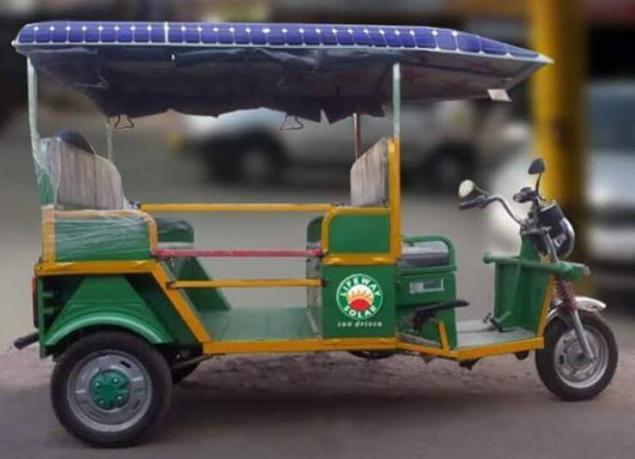
"My goal is to spread among people of culture of renewable energy for every day. I want them to have a habit to use electronica to explore the city. This will significantly reduce exhaust emissions," — said the owner of the company, Georgekutty Karunapala, adding that in seven Indian States rickshaws with electric motors are quite popular.
At the moment the project is under consideration in the Transport Department of the state. The entrepreneur hopes that approval will be received soon.
Thailand will release its electric car, the local Assembly's First compact electric vehicle local Assembly to be released in Thailand by the end of this year. It will be available for 300,000 baht.
The Japanese company FOMM Corporation announced the release until the end of the year the world's first four-seater electric vehicle that will be assembled in Thailand. Its preliminary cost is 300,000 THB.
FOMM Corporation works closely with Sirindhorn International Institute of Technology for research compact electric car in Thailand, reports Pattaya Mail.
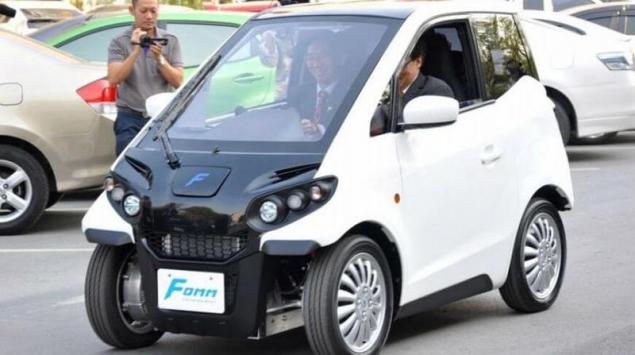
Currently, the Department of land transport should amend the law, which will allow you to register electric cars with engine capacity below 15 kW.
published
Source: altenergiya.ru/sun/novye-razrabotki-v-sfere-solnechnoj-energetiki.html
One of the authors of the development Hongrui Jiang explains that large photovoltaic arrays generating electricity from the charges moving vertically. New, little cells capture the current from the charges moving from side to side or laterally. Because of this, they generate significantly more energy than other solar system. A new generation side of solar cells can revolutionize the compact wearable device as the electrodes horizontally allows technologists to circumvent the traditional process of manufacturing a solar cell, when it is difficult to combine several layers of material one above the other.
Jiang says, "From the point of view of workmanship, will always be easier to make a lateral structure. Laying the vertical structure in several stages, is very challenging in small scale." The new solar cells reach an efficiency of 5.2 percent. "In other structures, a lot of volume is wasted. The technology that we have developed, allows a very compact side structures that take advantage of the full amount," say the creators.
Now, inventors are trying to make their solar panels are smaller and more efficient, by examining the materials, to further optimize the transparency and conductivity. Eventually, engineers plan to develop a flexible solar battery that can provide power to a tunable contact lenses.
Selenium can improve the effectiveness of tellurium-cadmium solar batteriesand much more effective than classic silicon as absorbing the same amount of solar energy use 98% less semiconductor material, but their efficiency can be improved.
Scientists have studied 4 solar panels with different levels of selenium and found that there is an optimal concentration of the alloy containing 50% cadmium, 25% of tellurium and 25% selenium. This alloy can improve the current efficiency of a tellurium-cadmium panels with 22.1% to 33% — a record high. If you exceed the percentage of selenium in the alloy, the result will give the opposite result with a decrease in the effectiveness of the panels.
"We have shown that the amount of selenium in the alloy of tellurium with cadmium depends on whether the form of small crystals in a solar cell crystal structure A or B — said Poplawski. — This information can be used as a guide for manufacturers to improve the tellurium-cadmium solar batteries supplements of selenium with a view to increasing their overall efficiency," — said the head of the team of the center for nanophase materials Jonathan Poplawski.
India appears rickshaws with electric motorsIn the state of Kerala in southwest India will soon appear rickshaws with electric motors, powered by solar energy. It is reported by Indian newspaper the Hindu. It is planned that they will replace so popular in the country tricycle motorickshaws.
Local entrepreneur hopes to launch the project on August 15 this year. These rickshaws are driven by an electric motor which will be powered by a battery, podzaryadit from solar panels installed on the roof. The batteries also can be recharged from a regular power outlet. Electronica has five seats and can travel on a single charge distance up to 80 kilometers. To collect it will be the company Lifeway Solar Private Limited in Kochi Kerala.

"My goal is to spread among people of culture of renewable energy for every day. I want them to have a habit to use electronica to explore the city. This will significantly reduce exhaust emissions," — said the owner of the company, Georgekutty Karunapala, adding that in seven Indian States rickshaws with electric motors are quite popular.
At the moment the project is under consideration in the Transport Department of the state. The entrepreneur hopes that approval will be received soon.
Thailand will release its electric car, the local Assembly's First compact electric vehicle local Assembly to be released in Thailand by the end of this year. It will be available for 300,000 baht.
The Japanese company FOMM Corporation announced the release until the end of the year the world's first four-seater electric vehicle that will be assembled in Thailand. Its preliminary cost is 300,000 THB.
FOMM Corporation works closely with Sirindhorn International Institute of Technology for research compact electric car in Thailand, reports Pattaya Mail.

Currently, the Department of land transport should amend the law, which will allow you to register electric cars with engine capacity below 15 kW.
published
Source: altenergiya.ru/sun/novye-razrabotki-v-sfere-solnechnoj-energetiki.html
